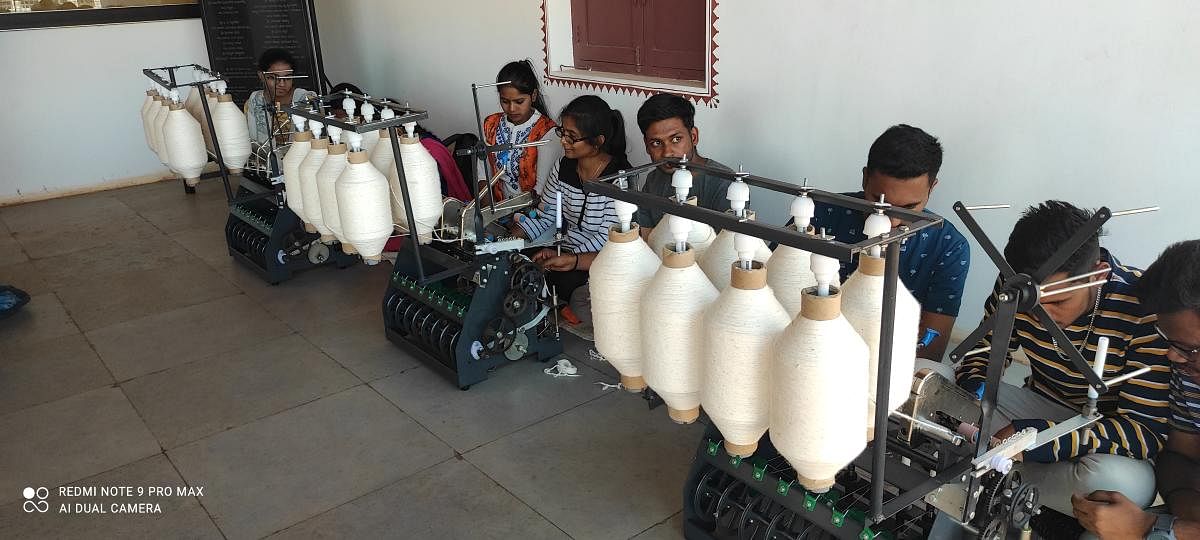
Mahatma Gandhi always propagated a village-centric model of development that would, in turn, develop the country.
This vision has served as the inspiration for setting up the country’s first Rural Development & Panchayat raj University in Gadag in 2016.
But the university did not want to restrict itself to just academics and intended to evolve into a place where Gandhian ideas are put into action. So it came up with its own ‘Sabarmati ashram’ on its campus near Nagavi village close to Kappatagudda.
The ashram was inaugurated on November 11, 2020 to mark 100 years of Gandhi’s visit to Gadag and was opened for public viewing in December.
“We wanted to personify the thoughts and values of Gandhi to show the younger citizens how relevant they are even in the current world. And what better than having a Sabarmati Ashram with a holistic ecosystem which inspired Gandhiji during the freedom struggle,” says University Vice-chancellor Vishnukanth Chatapalli.
Like the Sabarmati ashram in Ahmedabad, a statue of Gandhi sitting in a meditative position, sculpted by artist Krishna Nayak, welcomes visitors to the ashram. Spread out on five acres of land, the ashram and its gardens also include a Prarthana mandir, Kasturba mandir, Nayi Taleem mandir, a kitchen, a meditation hall and a library. The Ashram along with a garden and related spaces is spread on a five acre land.
The Prarthana Mandir has replicas of things used by Gandhiji, like the Charaka, his glasses, walking stick, pen and a drafting table. Keeping the ethos of rural development in mind, these items have been designed by local artisans using locally-sourced materials. The hall also has around 100 photographs describing the entire life and work of Gandhi.
The Kasturba Mandir has a photograph of Kasturba Gandhi and other photographs related to her life. It even has messages related to women empowerment.
The Nayi Taleem Mandir is used to impart skill-based training to students and locals. This is in line with Gandhi’s assertion that the brain must be educated through the hand. Here, students of the university learn to work at the Charaka.
Local Self Help Groups are given training on food processing, value addition of food and the like with an aim of rural empowerment and reconstruction.
“Since February, the students of the university have been voluntarily learning to use a charaka with the model charakas kept here and produce cotton yarn. This yarn is then turned into cloth, which is given to a handloom unit in Gadag. Such activities allow the students to understand the concept of Swadeshi in practical terms,” says Prakash Machenahalli, convener of the Ashram.
The library has over 500 books on Gandhian though, while the meditation hall offers a calm atmosphere to residents and visitors.
The lights here are solar-powered and the ashram is outfitted with rain water harvesting facilities.
“Replicating the entire structure of the Sabarmati Ashram was not easy. We had to pay several visits to the Ahmedabad Ashram to recreate the ambience and note down every detail. Sourcing the materials used a century ago was another challenge. For instance, Gadag is a heavy wind-prone zone and so, we had to get special micro-concrete tiles designed locally to get the look,” said Chatapalli.
To make the Ashram more vibrant, the university is making all efforts to orient the activities with Gandhian ideals. Every Friday, the entire university wears Khadi and every Saturday, there are activities like Gandhi Chintan Mathan where special talks by Gandhians are held.
Students and lecturers also read books on Gandhi and share the review with others during such programmes. This apart, there are satsangs (music programmes) where bhajans are sung.
In 11 months, well over 17,000 people have visited the ashram.
“Every Saturday, we visit the Ashram and engage in field activities like cleaning the Ashram, taking care of the livestock at the sheds located near the Ashram and nurturing the garden close to it. I even learnt how to spin the charaka. But the best part of the Ashram is that it is peaceful and thoughtful,” said Souparnika Koppal, a student studying MSc Geoinformatics at the university.
The university is also planning to launch a new Diploma course in Gandhian Thoughts and Actions, where students will be trained in various aspects of rural development. It also wants to engage postgraduate and undergraduate students of the university to create awareness on rural development in villages, and contribute towards empowerment of villages.
The Ashram is open for visitors on all the seven days from 10:00 am to 5:30 pm.